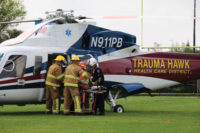The issue recently came up at Towson University, outside of Baltimore, Md. when the university was asked how it communicates with students and staff in an emergency. It’s not an easy thing to do, considering that the university encompasses more than 40 buildings, covering 328 acres within the town of Towson.
“When weapons of mass destruction or the possibility of a hazmat incident came up, we had to ask ourselves if we could realistically notify the staff and student population of an emergency situation in time to make a real difference,” said Paul Parrish, Towson University’s environmental health and safety officer. “It was about the same time that the Virginia Tech shooting took place. This placed our MNS (mass notification system) project on a fast track.”
At the time of the University Tech shooting, Towson was using a text messaging system to alert students, staff, parents and others. While the alerts proved to reach a good portion of Towson’s population, university officials knew it was not a comprehensive solution.
“We also have an outdoor public address system consisting of five [speaker] towers. University Police recently installed them on select buildings to provide adequate campus-wide coverage,” said Parrish. “But we realized that this was not enough. We also needed mass notification inside our buildings.”
The university already had standalone fire alarm EVAC (emergency voice/alarm communications) systems in half of its buildings. However, the systems operated independently, requiring users to be located within each building to activate communications.
According to Parrish, it was obvious the EVAC systems were not an effective option when faced with an immediate threat, such as a tornado alert. Hazardous spills and other hazmat-related incidents involving a nearby, major highway was another concern driving the initiative.
Parrish worked with fire protection contractors, Fireline Corp., to connect the EVAC systems together so the university could make announcements from a single location on campus.
An Integrated Approach Saves Money
Twenty of the schools’ buildings are now equipped with Notifier EVAC systems featuring standard pre-recorded messages and microphones for users to provide real-time announcements. Systems in seven of the buildings categorized as high-rises also include firefighter phones that enable first responders to communicate directly with each other.
Currently, Fireline is upgrading the remaining school buildings to include ONYX Series EVAC systems from Notifier. Once complete, all buildings’ systems will feature both fire alarm and mass notification protection, all of which will be tied together for centralized, campus-wide control.
Parrish added: “It’s better to upgrade to EVAC technology now, as opposed to traditional horns. So when mass notification is needed, the transition will be smooth and cost effective.”
Uniting a Community During a Crisis
The Fargo Public School District (FPS) was able to communicate school closures and to recruit thousands of volunteers to aid in the sandbagging effort. Over a period of 22 days, more than 152,000 messages were sent, which resulted in thousands of additional student and parent volunteers joining to protect the community.
The FPS serves 11,400 students and employs more than 1,000 people. It also oversees more than 22 instructional buildings, including two high schools, three middle schools and 15 elementary schools.
While Fargo’s “500-year flood” was thought to have occurred a decade earlier in 1997, the combination of heavy winter snows, spring rain and rapid thawing in March 2009 soon had officials realizing a second flood was imminent. Many of the district’s buildings are proximal to the Red River, and Fargo’s flat topography means that even a small rise in water levels can cause damage to nearby structures. Sandbagging helped, but as water levels rose, it was evident that sandbag production would have to increase. The district assumed that high school students and their parents might help if they could be reached on a one-on-one basis and given instructions.
While the district had used a Blackboard Connect service for day-to-day messaging, it had not yet employed the service in an emergency or crises situation.
On March 19, administrators sent out 2,979 phone messages to North High School and South High School students and parents. “We asked students to bring a permission slips from parents/guardian and comes dressed to be outside sandbagging,” said Lowell Wolff, Assistant to the Superintendant. “When crunch time came on March 26 and we didn’t have enough volunteers, we used the emergency mode. It generated an additional 6,000 volunteers – a community saver.”
The next day, more than 2,200 students and parents volunteered. Over the next few days, as flood waters rose, the district recruited even more volunteers. When sandbag production became a 24/7 project, the district also used the service to notify parents and students of school cancellations.
A week later, the district sent the message district-wide to 21,116 residents. An estimated 6,000 volunteers showed up to help again.
By the time the river began to recede, more than 3.5 million sandbags had been placed, and the district had sent out more than 150,000 flood-related messages to students, parents and community members. For the district, the ability to communicate directly with students and parents proved instrumental in protecting the community from the flood waters. “At its highest point the river level was six inches below the highest sandbag,” said Wolff. “If sandbag protection had failed, we would have lost three schools. We were able to carefully construct all of our messages. In recruiting volunteers, details were critical. Students and parents had to know where to go, what to bring, as well as what would be provided by the district.”
Wolff added, “At times like these, the ability to deliver a carefully crafted message without the distortion introduced by using the mass media is extremely valuable. We had many examples to distorted messages that sent equipment and volunteers in opposite directions – but that didn’t happen when the messaging system was used.”
A Security Playbook for the Cleveland Browns
The organization uses Send Word Now Alert Service as part of its security plan. Merletti said he chose the service after speaking with former Secret Service colleagues who used the system.
Kat Mathis, an associate in security office who formerly worked for the CIA, said that previously, the organization did not have a system where all necessary personnel could be contacted simultaneously with one message. “It was merely a matter of certain people being responsible to contact members in their departments through a ‘chain of command’ process,” she said.
Now, any message the security team wants to communicate is sent through cell phones via a phone mesage and/or email and text messages.
“So far we’ve used the system to notify personnel of inclement weather (a yearly hazard in the Ohio area) that has delayed or closed offices, and also to advise of emergency-type situations that entailed an emergency-type response during an event. ranging anywhere from a major issue like a water main break to a more simplistic issue like a major change in schedule,” Mathis said. “Fortunately, we have not needed to alert anyone of any ‘terrorist’ type situation, but of course, and due in large part to the horrific incidents which took place on 9/11, that was a consideration for us in looking for a way to quickly notify all personnel immediately as we could possibly present an attractive venue for a terrorist hit with the capability of more than 75,000 people attending and working a single event at our stadium.”
Propagating Awareness through Open Air
With disparate campuses and parking lots, the university has unique security concerns, one of which is the ability to respond to respond to emergency calls, monitor emergency situations and to initiate emergency notifications.
To increase its response times and abilities, it recently installed 18 Wide-Area Emergency Broadcast System (WEBS) towers from Talk-A-Phone. The towers allow a caller to push the information button and immediately get connected to the OCU’s switchboard, where campus security personnel can assist the caller with both emergency and non-emergency matters. The new phones are visible and accessible to all OCU’s visitors and resident at all times.
The towers have an audio broadcast capability that allows security authorities to specify individual nodes or multiple broadcast zones to relay audio messages at peak 123 dBA. The sound pressure level can be adjusted to broadcast over shorter distances, depending on the area one is trying to cover.
“One of the reasons why we decided to go with [this solution] is we could make broadcast announcements on them. They could be used for information and also emergencies,” said Lyndel Harris, the chief of Police at OCU. He added, “Someone new to the campus could hit the information button, which goes directly to our switchboard, and from there they can receive any information about the campus that they need to know.”
The university has plans to expand the system and install more emergency response phones throughout the campus, and to use it for crowd control. “Eventually, we are going to … have a broadcast system in every building on campus,” Harris said. “That will allow us to broadcast a message through the phones if we have an active shooter; everyone is going to be notified by the intercom system in there.”
Disaster Response Using the World Wide Web
For example, in addition to their physical response activities, first responders in the Gulf of Mexico had to find a way to keep employees, students and family members informed about their actions and plans. This required them to quickly and accurately deliver information to targeted individuals, such as those whom they believed would be most affected by the storm.
Twelve Houston, Texas-area organizations, including the U.S. Coast Guard, a port authority, a major university, several oil companies and city and county governments used PIER Systems (Public Information Emergency Response), an Internet-based communication management system to communicate with the media and the public before, during and after the storm.
The system communicates important information and allows users to respond to messages by submitting questions or concerns online. The system captures and tracks the submissions, allowing communicators to deal directly with each individual. Throughout Hurricane Ike, for example, system users posted and pushed more than 220 different updates to more than 43,000 different stakeholders, and the system’s sites dedicated to the storm received more than 7.7 million hits from almost 200,000 unique visitors. While power went out, phone lines went down, streets flooded and vital services were interrupted, the system remained functional and accessible and it allowed responders to maintain clear and direct communications.
Because the system resides outside of an organizations’ IT infrastructure and is hosted on geographically dispersed, high-volume servers, access is from any web browser. Many functions are also accessible via mobile devices such as Blackberries and iPhones.
Protecting the President
Internal Communications
The District of Columbia (DC) and surrounding jurisdictions used an emergency text messaging system from Cooper Notification’s Roam Secure Alert Network (RSAN), to coordinate the largest security and safety operation for a presidential inauguration in the nation’s history.
During the events, RSAN provided internal communications among the law enforcement agencies. It allowed DC HSEMA and its counterparts to respond to emergencies by sending text messages to coordinate efforts among the different law enforcement agencies, including the Metropolitan Police Department (MPD), U.S. Secret Service, U.S. Capitol Police, FBI and the U.S. Military.
The majority of internal messages sent by DC HSEMA to law enforcement personnel were for managing crowd control. Other alerts included dismantling of security check points, sending bomb squads to for checking suspicious bags, scheduled street closures and non-scheduled street closure notifications, for example, a water main break on 7th Street and even sending fire marshals to Inaugural Balls.
External Communications
Alert DC also enabled officials to communicate emergency information to the public via text messages during the four-day ceremony.
Residents and visitors in the
Alerts weren’t limited to just emergencies. Residents could also receive information on inclement weather and transportation issues. Specific alerts sent to the public during the inaugural events included information on shutting down the Washington Metro line due to accident, road and bridge closures and openings, and winter weather advisory.
Mass Notification Standards
The DoD standard was made possible through a collaborative effort between the U.S. Air Force and the NFPA (National Fire Protection Association). In June 2009, the NFPA established similar MNS requirements under Chapter 24 of its NFPA 72: National Fire Alarm and Signaling Code 2010 version. Referring to MNS as Emergency Communications Systems, the new NFPA code spells out rules for the design, installation and testing of these systems within public and private sector facilities.
Testing Special Needs
Underwriters Laboratories, for example, now has its 2572 standard for emergency communications/mass notification systems. The UL requirements cover discrete electrical control units, communication units, distributed recipient mass notification control units and dedicated targeted individual receiving equipment, high-power speaker arrays, transport products which manipulate the data packets, and accessories for mass notification systems to be employed in accordance with the NFPA 72.
Often, the products covered by UL 2572 are intended to be used in combination with other appliances and devices to form an emergency communication and/or mass notification system to communicate critical information within buildings and/or outdoor areas about emergencies including but not limited to terrorist activities, other dangerous situations, accidents, natural disasters and the like. Communication is through voice instructions as well as alert and evacuation signals.
For UL listing, audible notification appliances are to be assessed to the Standard for Audible Signaling Appliances, UL 464. Visible notification appliances are to be assessed to the Standard for Signaling Devices for the Hearing Impaired, UL 1971, or the Standard for Visual Signaling Appliances - Private-Mode Emergency and General Utility Signaling, UL 1638, as applicable. Textual visible appliances are to be assessed to UL 1638.
Testing of emergency and mass notification systems is also an important exercise.
Often, testing is on a monthly basis. For instance, North Carolina’s Appalachian State University conducts a monthly test of the campus siren warning system. The test activation consists of a 75-second discontinuous air horn tone followed by a pre-recorded voice message that says, “This is a test. This is a test of the emergency warning system. This is only a test.” The all-clear activation consists of a 20-second alert tone followed by a pre-recorded voice message that repeats the message, “All clear. The emergency is over.”
Appalachian State University, as do most colleges and universities, uses multiple methods to notify and communicate emergency information to the campus community.
- An active shooter on or near campus.
- A major hazardous material spill on or near campus.
- Tornado warning for the campus.
To prepare the UTSA and surrounding communities for system testing, the university works with apartment complexes, neighborhood associations, businesses, media outlets, the San Antonio Office of Emergency Management and others to provide information on the system and testing timetable. Reverse 911, Giant Voice, video and the Internet are all facets of an intensive effort to inform students, faculty, staff and visitors of emergency situations.
Within the emergency management plan at the University of Chicago, there are additional procedures for persons with disabilities. It tells all members of the university community that they have “a responsibility to facilitate the safe evacuation and sheltering of persons with disabilities.”
A first step at the university: all individuals, including those with disabilities, who may need assistance in an emergency, are asked to identify themselves to the university. Once an individual has self-identified, the university works with each of these individuals to develop a personal emergency plan that includes specific evacuating and sheltering procedures and means of communication in the event of an emergency. The university is also committed to training its employees, beyond security, to identify and assist persons who may need assistance in an emergency.
To follow through on its commitment, twice a year, the university asks all faculty, students, and staff if they will require assistance in an emergency. Self-identification is voluntary and privacy protected; the purpose of the request is to assemble information to assist in alerting, evacuating, or sheltering individuals in case of an emergency.
Police Twitter, Too
For example, the Brattleboro, Vt., Police Department sends out tweets to alert residents about immediate road hazards or closings, information about locating suspects as well as other information. The department, as well as most other police agencies using Twitter, don’t update as regularly as teenagers and celebrities, who have embraced this new means of communication. Recent posts from the department included information on the department’s new hallway monitor that shows high risk sex offenders and wanted persons, a grant it received from the Office of Justice Program with funding under the FY09 Recovery Act Edward Byrne Grant and a warning to Brattleboro residents to lock their vehicles at night to prevent thefts. If you want, you can also receive an RSS feed of the department’s Twitter postings.
Twitter is a free social networking and micro-blogging service that enables its users to send and read messages known as tweets. Tweets are text-based posts of up to 140 characters displayed on the author’s profile page and delivered to the author’s subscribers who are known as followers. Senders can restrict delivery to those in their circle of friends or, by default, allow open access. In college and police mass notification applications, the circle can be a database of campus people or city residents.
Users can send and receive tweets via the Twitter Web site, Short Message Service (SMS) or external applications. While the service costs nothing to use, accessing it through SMS may incur phone service provider fees.



